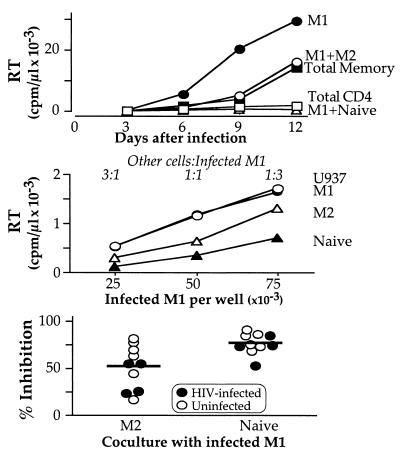Figure 3.
Coculture of infected M1 with M2 or naïve inhibits HIV replication. Cells were sorted and infected as described in Fig. 1 and stimulated with anti-CD3/CD28 beads. (Top) Both M2 and naïve cells inhibit HIV replication when added to M1 cells; only naïve T cells reproduce the suppression observed in total CD4 T cell cultures. (Middle) RT activity in culture supernatants 6 days after infection and stimulation with anti-CD3/CD28 beads correlates with the initial number of infected M1 cells in all coculture conditions. M1 cells were plated at the indicated concentrations and stimulated with anti-CD3/CD28 beads (3 beads/cell); uninfected U937, M1, M2, or naïve cells were premixed with anti-CD3/CD28 beads and added to M1 cells at the final concentration of 5 × 105 cells/ml (1 × 105 cells/well), resulting in different cell/cell ratios (1:3, 1:1, and 3:1). Both naïve and M2 cells inhibited viral replication in M1 cells; addition of uninfected M1 or U937 cells had no effect. A mild dose-dependent effect of the naïve and M2 cells was observed (not shown). (Bottom) HIV-infected (filled symbols) or uninfected (empty symbols) M2 or naïve cells were premixed with antiCD3/CD28 beads and added to infected and infected M1 cells at a 1:1 ratio; data are shown for 10 independent experiments. The inhibitor effect of naïve T cells was consistently greater than that of M2 cells and was independent of whether or not they were infected.

